Golf Clubs Explained for Beginners
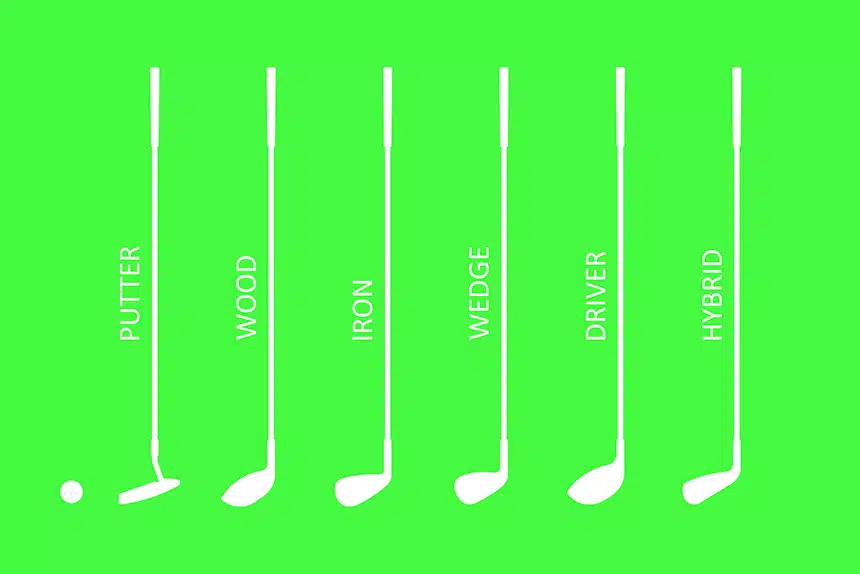
If you don’t understand the different golf clubs that are a part of this hugely popular sport, then this comprehensive Golf Clubs Explained guide is specially created for you!
By the end of the article, you’ll know what types of clubs are there, what their purpose is, and what golf club to use for each shot.
Simply put, there exist 5 different types of golf clubs. Namely, woods, irons, hybrids, wedges, and putters. But not all woods, irons, hybrids, wedges, or putters are the same. Sometimes the clubhead size differs, sometimes the length of the shaft is different, and sometimes the loft angle of these clubs varies.
It can all be quite confusing if you’re a beginner, but that’s just normal. So how about I discuss the basics of all the different types of golf clubs!
Golf Clubs – What Are the Different Types and How Do They Work?
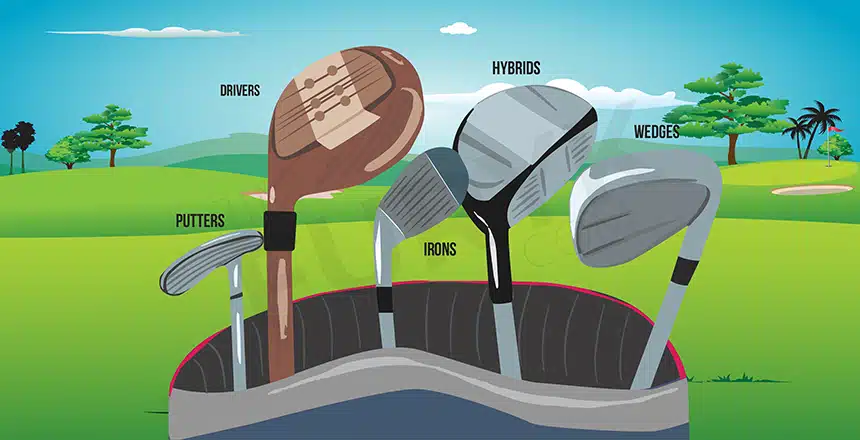
1. Driver
In the list of golf clubs, the driver, also known as 1-wood, is built with the biggest clubhead and longest shaft. Drivers are long-distance golf clubs that you use off the tee – your first shot on par-5 or par-4 (meaning of ‘par’ explained).
More often than not, golf drivers feature lightweight, thus easy-to-swing graphite shaft with clubhead made of carbon, titanium, or steel.
The clubface of a typical driver is the largest in comparison to other clubs, and this actually works in the favor of those with a slower swing speed. For example, the best drivers for women, best drivers for seniors, and best drivers for beginners. ALL are equipped with a broader hitting or impact zone because of the bigger 460cc clubhead size (the largest legal limit).
Larger heads are more forgiving, which means you can hit as many off-center strikes and your drives will still travel straighter and longer – it’s only logical.
Now of course there are golf drivers with relatively smaller clubheads too (440cc or less), but these perform better in the hands of more advanced golfers. Smaller clubheads are more preferred by better players because the smaller size allows them to intentionally curve their shots either right (for a fade) or left (for a draw).
Furthermore, advanced technologies have come about in the past decade or so. For instance, golf driver adjustability. Adjustable features in a driver means you can change the loft setting of the club and slide weights (center of gravity) around for optimizing the shot shape, launch angle, and trajectory.
In simpler words, if you want your shots to go higher, then you need to increase the loft and move the CG of the golf club farther back. Another way to explain this – positioning more weight in the heel area of the driver for a more draw-biased approach in order to reduce the effect of always slicing the ball.
Then there are technologies for maxing out ball speed as well, irrespective of your swing speed. A boost in ball speed automatically translates into an increase in distance. And to be honest, even affordable golf drivers can be so high-performing!
2. Woods
Apart from the driver, there are other woods too that, just like drivers, are used to hit long shots. Teeing off with a driver first and then your second shot also requires you to pick up a wood to gain those extra yardages. And just like the driver, even the fairway wood is outfitted with a larger clubhead.
Back in the days, these types of golf clubs were actually built using wood (hence the term ‘woods’) but now metal is used for their construction.
But why switch to metal? The primary reason behind that is that only through the precise molding of metal can a low center of gravity and perimeter weighting be achieved. And when that happens, the results include higher launch + less spin (through low CG) and mis-hit correction + easier, higher launch (through perimeter weighting).
So it’s safe to say that these fairway woods push the legal limits of ball speed to produce greater distance. And you use them within 175 yards or so from that green. But remember that shorter than 175 yards and your woods won’t prove to be as effective!
The most common fairway woods for the second shot include 3-wood and 5-wood. The former has a loft of 15-18 degrees while the latter’s loft angle is between 20 degrees and 22 degrees.
And now let me explain something relevant and very, very important here so you know which to choose, 3-wood or 5-wood. When golf clubs are lower-lofted, they may be perfect for generating long distances but they’re not the best for producing good height.
That’s precisely why drivers with a low loft (between 7 degrees and 12 degrees) are low-launching. Therefore, you ought to pick a lower-lofted 3-wood for distance but a higher-lofted 5-wood for launch.
The least common fairway woods are 2-wood and 4-wood. The 7-wood golf club is also an option and one that’s gaining more popularity over recent years because of its remarkable ability to get the ball out of rough much more easily. Thanks to the extra loft angle of course!
3. Irons
Within 200 yards – that’s when your golf irons are ready to make their appearance. The closer the green gets, the higher the number of iron you should be using. Any typical set includes a 3-iron, 4-iron, 5-iron, 6-iron, 7-iron, 8-iron, and pitching wedge.
With these, you can play both long-range (from the tee) and short shots. However, for acing those tee shots, driving irons are the most fitting choice, although they’re better suited for more skilled players.
In general, golf irons have a comparatively thinner profile than woods and even hybrids. And it’s this very thin structure itself that improves accuracy as you’re inching nearer to that hole.
Moreover, irons have a clubhead with deeper grooves extending across the toe-to-heel region of the face. And the job of grooves is to create spin. But then only the highly experienced part of the golfing population can use this particular feature to its advantage.
And now here are the 2 different types of irons in golf…
CAVITY-BACK IRONS
If you’re a beginner and/or high handicapper, then your iron shots will soar not only higher but straighter too with cavity-back irons.
The cavity of the face is at the back in these types of irons, which implies perimeter weighting. And when golf clubs are perimeter-weighted, they’re the best for achieving accuracy and the best in terms of mis-hit or off-center forgiveness (thanks to the larger sweet spot).
In comparison to the conventional design, cavity-back also generates a higher (more effortless) ball flight. This must now explain why the best irons for beginners and seniors are all cavity-back. So a slow or below-average swing speed doesn’t wreck your iron game!
And just because cavity-back irons are easier to hit and so much more versatile, they’re an outstanding investment for not just beginner and high-handicap golfers but also for intermediate to mid-handicap players. (Best Mid-Handicap Irons)
BLADE OR MUSCLE-BACK IRONS
The traditional blade framework is quite challenging to work with, which makes blade or muscle-back irons a more suitable option for players with developed golfing skills.
The most important benefits of using blades include a high level of playability and their increased capacity for showing mistakes. What these types of irons do is help in shaping your shots through greater control over draws and fades.
But then, unfortunately, with muscle-back irons, you can’t acquire consistency nor do you get that much-needed forgiveness if you’re more likely to hit off-center.
So cavity-back vs. blade irons, it’s all about choosing between greater forgiveness and more control.
4. Hybrids
Moving on to long-iron alternatives, hybrids!
A hybrid, as you can surmise yourself, is the merger of woods’ head and irons’ shaft length (best of both worlds indeed). This combination, no doubt, benefits a great number of golfers, irrespective of their skills and techniques.
3-iron and 4-iron (i.e. the longer irons) are definitely not even remotely easier to hit, which is why they’re often replaced with a hybrid for advancing workability as well as gaining more of that game-enhancing mis-hit forgiveness. That’s why beginner-friendly hybrids are so popular these days. Even hybrids for seniors are like that, meaning easier-to-hit long-iron alternatives.
5. Wedges
These golf clubs are quite useful, that’s for sure. And every player carries at least 1-2 wedges in his/her golf bag.
Now here are the different types of wedges… (You can read the detailed Golf Wedges Explained here)
GAP WEDGE (around 50 degrees)
This one’s the most suitable for when you want to generate some considerable distance. And it’s actually more preferred for distance despite the gap or approach wedge golf club also providing great accuracy as well.
SAND WEDGE (54-58 degrees)
It’s the most common wedge in the game of golf. The sand wedge is perfect for those unfortunate situations when the golf ball gets stuck inside a bunker. It does a better job of getting that ball out of the bunker and flying into the air than it does for hitting long-distance shots.
LOB WEDGE (60 degrees)
A 60-degree lob wedge does indeed get the golf ball really high, with a lot of spin. This way, you can more effortlessly get the ball spinning toward the back of that hole. Meaning a lob wedge will place more power into your hands for manipulating shots around the green.
PITCHING WEDGE (45-48 degrees)
PW or Pitching Wedge is often a part of golf iron sets. This particular wedge is never sold or bought individually.
In comparison to other wedges, this one, with its deeper, narrower grooves and higher CG, can give rise to a more penetrating trajectory. Along with that, you also get more spin and consistency.
So a pitching wedge is the best for playing approach shots from the rough or fairway. Or simply when you wish to gain a higher trajectory on short-range (around the green) pitch shots. Pitching wedges produce distance and spin as well as hands over more control for delivering accurate and tight short game performance.
6. Putter
You putt the golf ball into the hole, right? This means your putter must be very carefully selected, so you can hit those low-speed, short strokes the most accurately.
Putters, more often than not, have a steel shaft but the clubface can differ. Speaking of which, here are the different types of putters in golf…
BLADE PUTTER
With its comparatively smaller clubhead, a blade putter, most common among Tour-grade players, paves the way for more accurate putting.
MALLET PUTTER
As opposed to more lightweight blade putters, mallet putters are heavier because of the larger head. These top-heavy golf putters are specifically designed for the straight-back-straight-through putting technique. To put it simply, the putters are the best when your aim is to hit straighter putts.
Likewise, you have such incredibly forgiving TaylorMade putters that also get the golf ball to roll TRUE each time. And this forward roll is also more consistent and smoother, even in the case of off-center contact.
Related: Golf Club Types and Distances
How Many Clubs In A Complete Set of Golf Clubs?
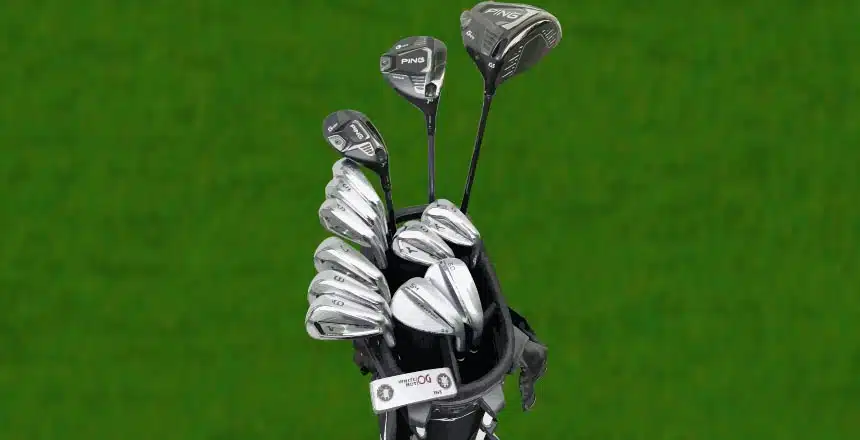
First of all, the USGA allows Tour players competing in tournaments to carry a maximum of 14 golf clubs. Amateur golfers, on the other hand, can carry more (even around 18-20 clubs) if they prefer easier-to-hit hybrids and other such clubs.
So what’s included in a full set of golf clubs? Typically, a set consists of a driver, a few fairway woods, 1 or 2 hybrids, 6 irons, 1 or 2 wedges, and a putter. Allow me to break it down for you below…
- DRIVER – The longest golf club in the complete set that you use for tee shots.
- FAIRWAY WOODS – If you’re a beginner, then your set of golf clubs includes just a single fairway wood, the 3-wood (to be honest, just one is more than enough). While more experienced players also like to have the 5-wood in the bag.
- IRONS – Normally, any traditional iron set includes 3-iron, 4-iron, 5-iron, 6-iron, 7-iron, 8-iron, and 9-iron. But, over the years, 3-iron and 4-iron have been replaced by hybrid golf clubs. And this is beneficial even for golfers with more experience.
- HYBRIDS – Speaking of which, hybrids are long-iron alternatives because they’re not just easier to hit but also deliver the distance and accuracy of long irons. No wonder they’ve now become such a natural part of ladies golf club sets.
- WEDGES – High-lofted wedges accomplish a specific goal. And so it’s highly recommended to carry 2 wedges – a pitching wedge (which you use when closer to the green) and a sand wedge (that is used to get out of sand traps and fairway bunkers). And of course, you can also add a lob wedge and gap wedge but then these two wedges are not generally included in golf club sets.
- PUTTERS – Every golf club set has to have a putter because this particular club is designed to play closer shots.
But are golf club sets worth buying? The advantages of golf club sets do include saving money because as a set, these basic clubs are less expensive. And if you’re a beginner, you also don’t have to go through the trouble of actually choosing the “right” golf clubs.
Also, if you have special preferences, and a complete set is designed to meet those demands, then everything works out for the best, doesn’t it? For instance, golf club sets for tall men or even complete junior golf club sets.
Golf Club Length Explained
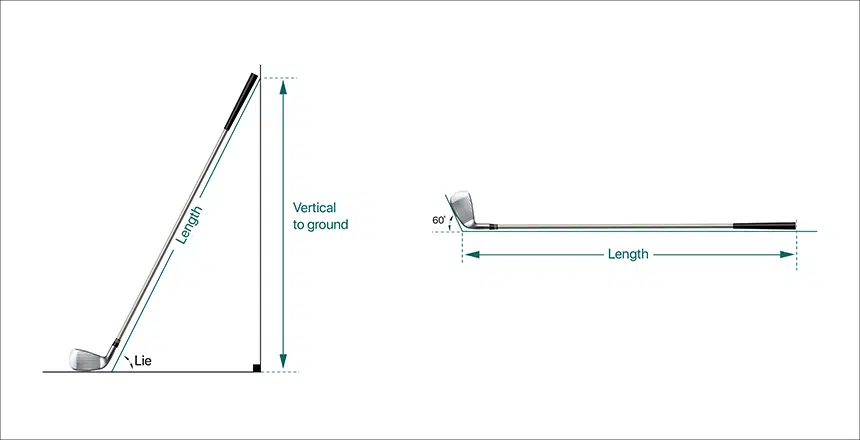
Why do golf clubs have different lengths, to begin with? Well, longer clubs (and if they’re more lightweight too), by default, promote a faster swing speed. The additional length provides more speed and leverage to make the golf ball travel farther upon solid contact. While shorter golf clubs prioritize not distance but precision.
The club shaft length should be long enough for touching the ground. Needless to say, this length is not the same for every player. Nevertheless, the standard length of golf clubs seems to be fairly and surprisingly uniform.
According to USGA rules, except for the putter length, all clubs should not be longer than 48 inches and shorter than 18 inches.
And now comes the graphite vs steel shaft length. Graphite shafts, in comparison to steel, are longer by typically an inch. And the reason is that more lightweight graphite, which promotes a faster swing speed for slow-speed golfers, is also longer for building even more clubhead speed. Meaning greater distance!
But then if you’re a slow-speed shorter golfer not comfortable with a longer shaft, you can always get professionally fitted or order shorter graphite shafts that are 1-inch shorter than the shortened version of steel shafts.
Where to Buy Used Golf Clubs?
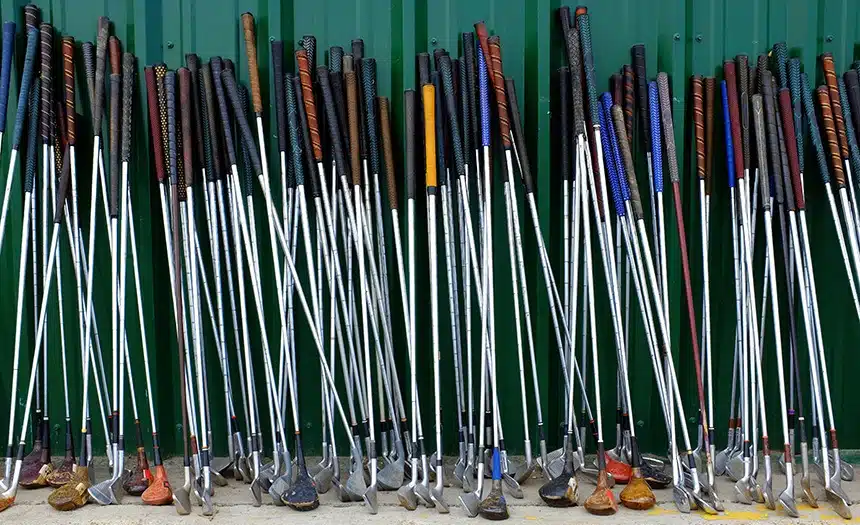
Are used golf clubs worth it? To be completely honest with you, it all depends on the condition of those secondhand clubs. If they’re good, condition-wise and in terms of fit, then there’s simply no denying that used golf clubs offer excellent value.
If you decide to purchase a brand new set of golf clubs, in comparison to that, buying the used version is definitely going to cost you much, much less. This is why so many intermediate and beginner golfers use hand-me-downs. The price point of these clubs is quite low – between $250 and $350 only for a whole set.
You just have to be careful when it comes to how and where to buy used golf clubs. The seller must be reputable and it helps if you can physically inspect the club or clubs before purchasing.
Complete Buying Guide for New Golf Clubs
Based on Golf Club Components
1. Clubhead
The clubhead is what makes contact with the golf ball, hence it launches the ball and controls its flight, trajectory, and ultimately, the distance it travels.
The general rule is that a larger clubhead size means you get more of that much-needed ‘mis-hit’ forgiveness if you’re a beginner. So the majority of brands install oversized heads (460cc is the max. legal limit) but then there are mid-sized and smaller-sized clubheads as well that are often chosen by more experienced players.
2. Loft Angle
The loft is the angle that forms between the ground and clubface. And every golf club is fitted with a different loft angle. A higher loft (45 degrees to 48 degrees of a 9-iron) equals to higher launch whereas a lower loft (21 degrees and 23 degrees of a 3-iron) increases distance.
And how can you tell if the golf club is higher or lower lofted? A more horizontal angle of the clubface means that particular club has a higher loft.
3. Shaft (Material & Flex)
There are two most common shaft material options – stainless steel and graphite. The latter is more lightweight, thus easier to swing faster (and thus, more suited for those with a slower swing speed). It’s really as simple as that as far as shaft material is concerned.
Even for shaft flex, this factor depends on your swing speed. Your options here are Regular (R), Stiff (S), Extra Stiff (X), Senior (A), and Ladies (L). Now it goes without saying that Regular-flex ranks as the most basic choice but then golfers with a slow swing speed prefer either Senior-flex or Ladies-flex.
As for pro-level players, they often choose Stiff-flex or even stiffer shafts since these are well-engineered to handle their faster swing speeds.
4. Hosel
Why is golf club hosel an important feature here? Well, because the thing connects the head of the club to its shaft, which means that the lie angle is largely dependent on the hosel.
Generally, drivers, woods, and also hybrids are designed with an adjustable hosel. So you can optimize launch angle as well as spin rate by changing the loft settings. Putters, wedges, and irons, on the other hand, don’t offer this kind of loft adjustability since their design consists of pre-set, specific lie angles.
Based on your swing speed and height, you can adjust the hosel of your woods and hybrids. Although this is a more common practice among advanced golfers who prefer customizing their clubs from the standard setting.
5. Grip
Grip size and thickness are what matter the most. Too thin and your hand actions into and during your golf swing will be unnecessarily large. And too thick leads to restricted hand movement. Thus, both produce a similarly unfavorable effect on the swing.
As for grip size, should you select oversized, midsized, or standard? Bigger hands certainly benefit more from a thicker and larger grip. For pretty much the same reasons, putter grips, more often than not, also have a thicker grip, so your wrists and hands are more inactive when performing a solid putting stroke.
If you’re confused about any or all of it, it’s best to choose a standard grip, which is often a part of generic golf club sets. And if uncomfortable with this standard grip, then you have the option to get a customized grip.
Related: How to Grip A Golf Club Correctly
Based on Player Factors
1. Your Swing Speed
The slower your swing speed (below 90 mph), the more lightweight (graphite) and flexible (Regular-flex, Ladies-flex, or Senior-flex) the shaft should be. Only then can you add both height and distance to your shots.
On the contrary, faster swing speeds benefit more from stiffer (Stiff or Extra Stiff flex) and heavier (steel) shafts.
2. Your Handicap Score
HIGH HANDICAPPERS
If you’re a high handicapper, your shots travel a shorter distance with less accuracy. Correct?
In that case, your game would benefit more if you use ‘super game improvement’ golf clubs. These, no doubt, max out speed and distance through a larger clubhead and higher loft in the driver. As for the irons, these should be cavity-backs (oversized too) with low CG and high MOI, so the golf ball launches higher more easily.
The longest iron in your set is supposed to be 5-iron or maybe 6-iron. And of course, hybrids fill in that gap between the longest fairway wood and irons.
LOW HANDICAPPERS
What about if you’re a low handicapper? Proof – you’re consistency breaking 80!
For low-handicap players, a low-lofted driver works best in terms of producing enough distance and height. And the MOI should be lower too, which enables you to curve or work the golf ball more easily to the right or left. As opposed to a higher MOI that’s responsible for providing lots of off-center forgiveness.
Better golfers also prefer using muscle-backs or blade irons instead of the cavity-back design. Simply because, once again, the latter has proven to be more forgiving and lacking in terms of workability and feel. While blades have the opposite effect.
Then there’s a third option too that’s actually gaining momentum – forged cavity-back irons. These types of golf irons improve playability and feel while also focusing on factors like forgiveness and distance.
Lastly, pro-level players don’t mind including long irons rather than hybrids in their sets, unless even they prefer the latter because of its greater versatility and also because hybrids are easier to hit than long irons.
MID HANDICAPPERS
If you’re shooting between 80 and 90, you know you’re a talented golfer. However, maybe because of your still slower swing speed, mis-hits are a common occurrence. Hence, the need for a higher loft (between 10.5 and 12 degrees) and higher MOI for more distance, height, and accuracy.
At such times, cavity-back irons are the most suitable, and so are forged blades if you like. Your off-center shots will be well taken care of, no two ways about that. Although you might not be able to hit fades and draws.
What about deciding between long irons and hybrids? Hybrids are definitely the better choice here if you want to achieve more consistency from the rough, fairway, and tee.
3. Your Budget
Buying a complete golf club set is certainly more affordable than purchasing clubs individually. The more economical options (price tag below $400) are preferred by recreational or beginner golfers. These sets consist of 14 or fewer clubs (including 2 wedges and a putter of course) and a golf bag.
Mid-tiered, higher-quality golf club sets are designed for more advanced players. These are equipped with game improvement or super game improvement technology as well, just like the budget and beginner friendly ones. But because of the incorporation of more advanced components, the price may be higher (between $1,000 and $2,000).
Golf clubs worth over $2,000 are crafted for highly experienced/skilled golfers. The use of upgraded technology, design, and materials is the most prevalent in this particular category.
Golf Clubs Brands
In no particular order, these are the best golf club brands that all types of players can rely on in terms of performance, quality, durability, value, and some are even more inexpensive…
Callaway
Jon Rahm and Phil Mickelson are on the Team Callaway list. And you know, the brand’s Tour-level golf clubs are just as popular as their forgiveness and distance maximizing drivers and irons that compel shots to go longer and straighter in a more controlled manner.
Callaway’s game improvement technology, no doubt, in their ‘Mavrik’ and ‘Big Bertha’ range especially, is unparalleled in the whole arena of golf. Even Callaway Strata is immensely popular among beginners because it’s reasonably priced and features a larger clubface, graphite shaft, and perimeter weighting – ALL perfect for slow-speed golfers!
TaylorMade
Another reputable golf brand with Tour players like Tiger Woods and Dustin Johnson on their list. Even more average golfers have a lot to say about TaylorMade, and it’s because the team prioritizes not just professionals but also beginners and amateurs. TaylorMade SIM2 MAX Irons are proof of that.
And forget about TaylorMade irons and even TaylorMade drivers (although they’re just too phenomenal to dismiss), the brand also manufactures some of the best golf balls and golf bags.
Cobra
California-based Cobra, now owned by Puma, came up with the concept and design of utility golf clubs. This brand, just like Callaway and TaylorMade, also understands the importance of oversized clubheads, which is why even their game improvement irons are among the best-selling products.
As for Tour pros associated with Cobra, Jason Dufner, Bryson DeChambeau, and more are on the list. Even LPGA Tour champion Lexi Thompson uses the Cobra King Speedzone Driver.
Ping
The most forgiving golf clubs come from Ping. These reduce side spin, forgive mis-hits, and allow you to launch the ball much more easily.
Ping-manufactured clubs have proven to work the best for high to mid handicappers, all thanks to their game improvement technology.
Titleist
Titleist Pro V1 Golf Balls have made it to the top list of golf balls for beginners and seniors. And they’re also among the longest golf balls that increase yardages the most easily. So there’s no denying that this top, premium brand has revolutionized the design of the golf ball.
As for their golf clubs, these are more suited for lower handicappers. Just ask Justin Thomas, Scotty Scheffler, Nelly Korda, and more.
Mizuno
Much like Titleist, even Mizuno designs their golf clubs for more advanced, single-digit handicap players.
The forged irons manufactured by Mizuno are surely a delight to both perform with and look at. And of course, this one-of-a-kind craftsmanship comes with a quite hefty price tag.
Cleveland
Cleveland wedges are the best of the lot, especially Cleveland CBX 2.
But the brand’s Cleveland Launcher drivers and irons as well have made quite an impact.
Wilson
Now here’s a brand for all those newcomers in golf who don’t wish to spend big bucks yet want to purchase a high-quality set with clubs that are easier to hit. You’ll see many beginners, amateurs, and even recreational golfers carrying Wilson clubs.
So if you too are just getting into the game, it’s definitely worth checking out Wilson’s both used and brand new golf clubs.
Adams
If there was an Oscar for the best fairway wood, the Adams “Tight Lies” Fairway Wood would surely get nominated, and even win as a matter of fact. This model is THAT legendary!
The brand is quite famous for its easiest-to-hit woods and hybrids that ensure the straightest ball flight. For many, many dedicated players out there, Adams Tight Lies is indeed the go-to golf club.
Robin Golf
A more recent player in the golf market, that’s for sure. But Robin Golf is already attracting a lot of attention and in a good way. The brand manufactures premium golf clubs equipped with super game improvement technology, so even beginners and high handicappers can rely on them.
Any standard golf club set here is certainly not the most affordable. Nonetheless, in comparison to more recognizable or top brands, the cost is quite inexpensive. And the most important thing is that these clubs are all full of superior quality while also being extremely forgiving, easier to hit, and they also get the golf ball airborne more effortlessly.
FAQs
What Golf Clubs Should A Beginner Use?
When starting golf, you may not require more than a driver, hybrid or fairway wood (loft between 18 and 21 degrees), 6-iron, 8-iron, pitching wedge, sand wedge, and putter. Simply purchase one of those beginner or starter golf club sets, which are pretty affordable to buy. These also include the right kind of golf bag.
The whole point is to use easier-to-hit clubs that provide maximum mis-hit forgiveness, along with a higher launch/trajectory, straighter ball flight, and longer distance of course. That is why almost all beginners stay away from difficult-to-hit long irons.
Do Expensive Golf Clubs Really Matter?
What actually matters here is QUALITY. But, no denying, that it’s more common to find top-notch quality with high-end i.e. expensive golf equipment.
The material/construction of the shaft and other components, in this case, is definitely superior, thus offering better performance, feel, and swing consistency.
There You Have It, Those Were the Basics of Golf Clubs!
What is a golf club really? Just a stick with a head that strikes the ball, right? Well, if you’ve actually read the entire article, then you know that golf clubs are certainly more than just that. Components like the shaft, clubhead, grip, loft angle, etc. are as important to take into consideration as your swing speed, handicap, and maybe even budget.
The ultimate aim of renowned club manufacturers is to push the limits of physics to maximize your performance on the course, even if that performance consists of making swing errors. So you can still hit longer, straighter, and more accurately and consistently.
But then you, as a golfer and buyer, have to understand how different golf clubs function. Meaning which ones are more forgiving, for example, or which are better suited for a faster swing speed or lower handicap score.
The USGA allows you to carry only 14 golf clubs, so it’s your job now to make each one of them count in your every round of golf!
